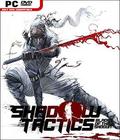Buy Shadow Tactics: Blades of the Shogun
Sometimes, both developers and publishers do something unexpected. Based on the information found on their company site, Mimimi Productions is comprised of children's apps and family-oriented games. Daedalic Entertainment is mostly known for its point-and-click adventures, like The Whispered World and the Deponia series. With Shadow Tactics: Blades of the Shogun, the developer gets into more mature territory, and the publisher moves into strategy. Luckily for the both of them, the result is excellent.
Shadow Tactics takes place in 1615, the Edo period in medieval Japan. After countless years of war and bloodshed, a powerful shogun has emerged to rule Japan to bring peace among the different nations. As expected, others are plotting against the shogun to bring about more war in order to gain control of the country themselves. With the enemy working in subterfuge, a team of unlikely specialists has come together to put a stop to the threat, if only to serve their own personal motivations.
As in many recent games, the solid but familiar story is backed up by a likeable cast of characters. Some are eccentric, like the sniper Takuma's love of haiku and his quirky personality. Others are curious, like the trap master Yuki, who's young and good at her craft but still seeks a sensei. The relationships between the five characters in your squad deepen over time, and by the end of the game, you'll enjoy each and every moment you spend with them.
The best way to describe the gameplay is that it occupies two complementary genres. The first is stealth, which should be readily apparent since you start the game as the ninja, Hayato. The major mechanics of the genre are here, from hiding bodies and seeing the vision cones of each civilian and soldier in your path. The cones are a little more advanced, as you can see what's blocking their vision as well as their distance, so you can be spotted but buy yourself a little time before the guard goes on high alert. Depending on who you're playing as, you can distract guards with thrown rocks, stray sake bottles or a whistle meant to emulate a bird call. You can also dispatch foes with things lying around the world, including wooden planks suspended in the air, oxen that kick when bothered, or large boulders that roll from hills.
The stealth segments are very well done thanks to a few restrictions. You may have some tools at your disposal, like a grappling hook to climb up places, but they are only activated when you reach certain hotspots. The same goes for attacks, as sword slashes and dagger stabs only occur once you get in range, preventing you from accidentally using them too far away and getting unwanted attention. You can still use shurikens to attack at any time, so you aren't completely restricted to hotspots.
At the same time, Shadow Tactics is meant to be very tough on everything but the easiest of difficulty levels. Guards are smart enough to immediately raise an alarm if they see an ally get hurt. They also realize when someone has left their post, and the time spent being suspicious is much longer than players may be used to. There's rarely an opportunity to return them to their routes once you accidentally pique their interest, and they'll even prod bushes and open doors, so hiding in one spot doesn't always mean you'll get away. This kind of thing is tough alone, but it's much more harrowing since you're in charge of at least two of the five pre-selected characters per mission.
In addition to the guards' heightened intelligence, the game makes everyone around you more formidable by placing them in very strategic spots. For example, you might see a guard by himself, but he's merely bait since someone with long-range vision is looking in his direction and ready to raise the alarm once something goes wrong. You'll have a shooter on a high post or the second floor of a building that has a good view of everything below him. There may be a civilian facing away from a guard but close enough to hear the trap go off and will alert others of what happened. There can also be a situation where a messenger is running between two guard groups and notices when something is amiss. It quickly turns a stealth game into a difficult living puzzle, and that's where the strategy comes into play.
The most obvious use of strategy is the management of the different abilities of each team member. There are times when the whirlwind slashing of the samurai Mugen is best to deal with tightly packed groups or Yuki's traps lets you lure guards away from others. One of the better strategy techniques is Shadow Mode, where you can plan the moves of your team and then execute them all at once in real time. For example, you can arrange it so a rifle shot hits one guard while a shuriken hits another guard at the same time. These tactics are often creative enough that you'll want to figure out different ways to be more efficient on the field by using these tandem moments. You're encouraged to do so, since they're often related to hidden goals and you can get medals for accomplishing them.
All of those factors come together to create an experience that is both mentally demanding yet highly satisfying. Each enemy and situation presents a conundrum, and you'll fail about as often as you'll succeed. To that end, the game supports up to three quick-save spots at any time, and it only takes one button press to initiate that save. If you aren't used to doing this from classic strategy games like the Commando series or Desperado, it may seem a little paranoid but necessary if you don't want to lose a good deal of progress. To help, the game reminds you to save if a minute has passed without doing so. It can be annoying, and there is an option to turn it off, but when you see that a seemingly short stage can stretch out for two or three times the expected length due to the high strategy and stealth levels, the reminders become very helpful.
There are only two things that will bother some players, though one isn't so much a flaw as it is a design decision. The first is the fact that the game features no auto-saving whatsoever. Aside from aggressively reminding you to perform quick saves, the game is expecting you to treat this like the old days and save everything manually. Hitting a cut scene does nothing, and the only form of automatic saving you can expect is the completion of a level and subsequent opening of a new one. For a game that hearkens back to a genre that was abandoned for a while, it is interesting to see it adopt some of the traits that have otherwise been abandoned by most titles, regardless of genre.
The second issue is load times, and unlike the saving system, there's no way to spin this into something good. Loading into the map for the first time takes a very long time, upwards of several minutes before gameplay finally begins. For a game that features 13 static maps, the waiting can be unusually long, and the developers even put notices on the loading screens to warn you of this. Thankfully, the extended load times only occur on the initial map load, and subsequent loads from quick save files are practically nonexistent. If you're trying to skip around from map to map and trying to mop up medals along the way, prepare to sit around for a while doing nothing.
Graphically, Shadow Tactics is pretty impressive for the genre. Environments are very well detailed, with nary a polygon out of place. The camera may be stuck in an isometric view, but the zoom and rotation are variable and are handled rather smoothly. The characters look and animate nicely, but there is a very thin black line surrounding each of them, so it looks influenced by cartoons.
From an audio perspective, the game does well. The music is effective but subtle, with Japanese instruments blending in well with the more Western ones. It plays throughout each stage, but it's never tiring to listen to, and it doesn't disguise any important sound effects or other helpful cues. The voices are done in both English and Japanese, and while the Japanese track is going to be the preferred by purists, the English track is just as good, provided you can live with a few quirks. Some of the characters, for example, still have mild Japanese accents, but others sport entirely British ones, making for an interesting hodgepodge of voices that are still taken seriously.
Shadow Tactics: Blades of the Shogun is a pleasant surprise. In a time when the genre is making a comeback, it adheres to some of the popular traits while still providing a fresh setting, an interesting story and a good set of characters. Stealth fans will love the level of intelligence in the enemies, while light strategy fans will love the various options at their disposal for accomplishing even the simplest of tasks. With a good presentation and solid controls for both keyboard/mouse and controller, Shadow Tactics is an excellent choice for anyone who's looking for the next strategy or stealth game fix.
Score: 8.5/10
More articles about Shadow Tactics: Blades of the Shogun










 Shadow Tactics: Blades of the Shogun is a real-time tactics game with stealth elements set during the Edo period of ancient Japan, time of the Shogun, Ninjas and Samurai.
Shadow Tactics: Blades of the Shogun is a real-time tactics game with stealth elements set during the Edo period of ancient Japan, time of the Shogun, Ninjas and Samurai.




























